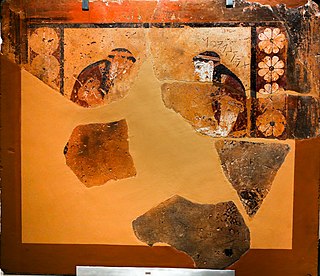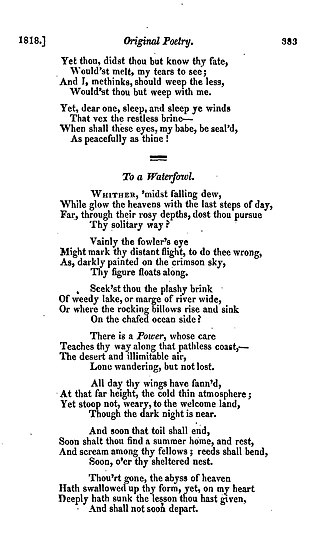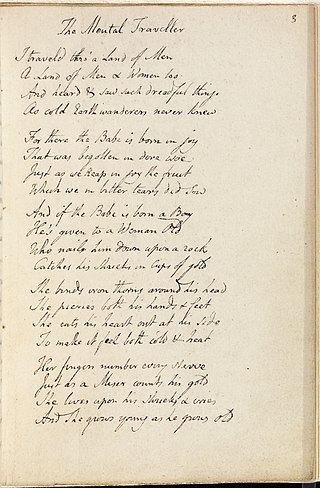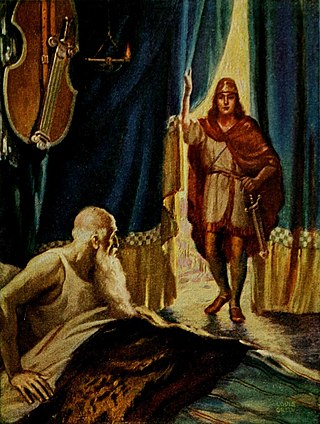Related Research Articles

Philomela or Philomel is a minor figure in Greek mythology who is frequently invoked as a direct and figurative symbol in literary and artistic works in the Western canon.

Matthew Arnold was an English poet and cultural critic. He was the son of Thomas Arnold, the headmaster of Rugby School, and brother to both Tom Arnold, literary professor, and William Delafield Arnold, novelist and colonial administrator. He has been characterised as a sage writer, a type of writer who chastises and instructs the reader on contemporary social issues. He was also an inspector of schools for thirty-five years, and supported the concept of state-regulated secondary education.

"Ulysses" is a poem in blank verse by the Victorian poet Alfred, Lord Tennyson (1809–1892), written in 1833 and published in 1842 in his well-received second volume of poetry. An oft-quoted poem, it is a popular example of the dramatic monologue. Facing old age, mythical hero Ulysses describes his discontent and restlessness upon returning to his kingdom, Ithaca, after his far-ranging travels. Despite his reunion with his wife Penelope and his son Telemachus, Ulysses yearns to explore again.

Jorge Manrique was a major Castilian poet, whose main work, the Coplas por la muerte de su padre , is still read today. He was a supporter of the queen Isabel I of Castile, and actively participated on her side in the civil war that broke out against her half-brother, Enrique IV, when the latter attempted to make his daughter, Juana, crown princess. Jorge died in 1479 during an attempt to take the castle of Garcimuñoz, defended by the Marquis of Villena, after Isabel gained the crown.

"To a Waterfowl" is a poem by American poet William Cullen Bryant, first published in 1818.

"Ode to Psyche" is a poem by John Keats written in spring 1819. The poem is the first of his 1819 odes, which include "Ode on a Grecian Urn" and "Ode to a Nightingale". "Ode to Psyche" is an experiment in the ode genre, and Keats's attempt at an expanded version of the sonnet format that describes a dramatic scene. The poem serves as an important departure from Keats's early poems, which frequently describe an escape into the pleasant realms of one's imagination. Keats uses the imagination to show the narrator's intent to resurrect Psyche and reincarnate himself into Eros (love). Keats attempts this by dedicating an "untrodden region" of his mind to the worship of the neglected goddess.
"A Red, Red Rose" is a 1794 song in Scots by Robert Burns based on traditional sources. The song is also referred to by the title "(Oh) My Love is Like a Red, Red Rose" and is often published as a poem. Many composers have set Burns' lyric to music, but it gained worldwide popularity set to the traditional tune "Low Down in the Broom"
A Darkling Plain is the fourth and final novel in the Mortal Engines Quartet series, written by British author Philip Reeve.
"To Marguerite: Continued" is a poem by Matthew Arnold. It was first published in Empedocles on Etna (1852), with the title, "To Marguerite, in Returning a Volume of the Letters of Ortis". In the 1857 edition, the poem is printed as a sequel to the poem "Isolation: To Marguerite." There, it first adopted the simplified title.
Nationality words link to articles with information on the nation's poetry or literature.

"Ode: Intimations of Immortality from Recollections of Early Childhood" is a poem by William Wordsworth, completed in 1804 and published in Poems, in Two Volumes (1807). The poem was completed in two parts, with the first four stanzas written among a series of poems composed in 1802 about childhood. The first part of the poem was completed on 27 March 1802 and a copy was provided to Wordsworth's friend and fellow poet, Samuel Taylor Coleridge, who responded with his own poem, "Dejection: An Ode", in April. The fourth stanza of the ode ends with a question, and Wordsworth was finally able to answer it with seven additional stanzas completed in early 1804. It was first printed as "Ode" in 1807, and it was not until 1815 that it was edited and reworked to the version that is currently known, "Ode: Intimations of Immortality".

Topographical poetry or loco-descriptive poetry is a genre of poetry that describes, and often praises, a landscape or place. John Denham's 1642 poem "Cooper's Hill" established the genre, which peaked in popularity in 18th-century England. Examples of topographical verse date, however, to the late classical period, and can be found throughout the medieval era and during the Renaissance. Though the earliest examples come mostly from continental Europe, the topographical poetry in the tradition originating with Denham concerns itself with the classics, and many of the various types of topographical verse, such as river, ruin, or hilltop poems were established by the early 17th century. Alexander Pope's "Windsor Forest" (1713) and John Dyer's "Grongar Hill" (1726/7) are two other often mentioned examples. In following centuries, Matthew Arnold's "The Scholar Gipsy" (1853) praised the Oxfordshire countryside, and W. H. Auden's "In Praise of Limestone" (1948) used a limestone landscape as an allegory.

Clash by Night is a romantic triangle drama by Clifford Odets which premiered on Broadway in 1941 and was later adapted to film and television. The title derives from Matthew Arnold's poem "Dover Beach" (1867):

The Mental Traveller is a poem by William Blake. It is part of a collection of unpublished works called The Pickering Manuscript and was written in a manner that suggests the poem was to be read directly from the collection.

"The Darkling Thrush" is a poem by Thomas Hardy. Originally titled "By the Century's Deathbed", it was first published on 29 December 1900 in The Graphic. The poem was later published in London Times on 1 January, 1901. A deleted '1899' on the poem's manuscript suggests that it may have been written in that year. It was later included in a collection entitled Poems of the Past and the Present (1901).

Sohrab and Rustum: An Episode is a narrative poem with strong tragic themes by Matthew Arnold, first published in 1853. The poem retells a famous episode from Ferdowsi's Persian epic Shahnameh relating how the great warrior Rustum unknowingly slew his long-lost son Sohrab in single combat. Arnold, who was unable to read the original, relied on summaries of the story in John Malcolm's History of Persia and Sainte-Beuve's review of a French prose translation of Ferdowsi. In Sohrab and Rustum, Arnold attempted to imitate the "grandeur and rapidity" of Homer's style which he was to discuss in his lectures On Translating Homer (1861). The poem consists of 892 lines of blank verse.

Tristram and Iseult, published in 1852 by Matthew Arnold, is a narrative poem containing strong romantic and tragic themes. This poem draws upon the Tristan and Iseult legends which were popular with contemporary readers.
"The Scholar-Gipsy" (1853) is a poem by Matthew Arnold, based on a 17th-century Oxford story found in Joseph Glanvill's The Vanity of Dogmatizing. It has often been called one of the best and most popular of Arnold's poems, and is also familiar to music-lovers through Ralph Vaughan Williams' choral work An Oxford Elegy, which sets lines from this poem and from its companion-piece, "Thyrsis".
"It is a beauteous evening, calm and free" is a sonnet by William Wordsworth written at Calais in August 1802. It was first published in the collection Poems, in Two Volumes in 1807, appearing as the nineteenth poem in a section entitled 'Miscellaneous sonnets'.

"A Cradle Song" is a poem written by William Blake in 1789, as part of his book Songs of Innocence.
References
For a more thorough bibliography see Matthew Arnold.
- Professors Chauncey Brewster Tinker and Howard Foster Lowry, The Poetry of Matthew Arnold: A Commentary (New York: Oxford University Press, 1940), Alibris ID 8235403151
- Kenneth Allott (editor), The Poems of Matthew Arnold (London and New York: Longman Norton, 1965), ISBN 0-393-04377-0
- Park Honan, Matthew Arnold, a life (New York: McGraw-Hill, 1981), ISBN 0-07-029697-9
- A. Dwight Culler, Imaginative Reason: The Poetry of Matthew Arnold (New Haven: Yale University Press, 1966).
- Stefan Collini, Arnold (Oxford: Oxford University Press, 1988), ISBN 0-19-287660-0
- Linda Ray Pratt, Matthew Arnold Revisited, (New York: Twayne Publishers, 2000), ISBN 0-8057-1698-X
- The text of the poem is as in Poetry and Criticism of Matthew Arnold, edited by Dwight Culler, Boston: Houghton Mifflin Company, 1961; ISBN 0-395-05152-5 and Matthew Arnold's Poems ed. Kenneth Allott (pub. J. M. Dent & Sons Ltd, 1965). The editors of this page have opted for the elided spellings on several words ("blanch'd," "furl'd") consistent with these texts.
- Melvyn Bragg, In Our Time – Victorian Pessimism, BBC Radio 4, Thu 10 May 2007
